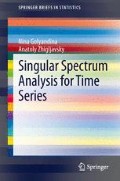Abstract
Singular spectrum analysis (SSA) is a technique of time series analysis and forecasting. It combines elements of classical time series analysis, multivariate statistics, multivariate geometry, dynamical systems and signal processing.
Access this chapter
Tax calculation will be finalised at checkout
Purchases are for personal use only
References
Alexandrov T, Golyandina N, Spirov A (2008) Singular spectrum analysis of gene expression profiles of early drosophila embryo: Exponential-in-distance patterns. Res Lett in Signal Process 2008:1–5
Allen M, Smith L (1996) Monte Carlo SSA: Detecting irregular oscillations in the presence of colored noise. J Clim 9(12):3373–3404
Azulay DO, Brain P, Sultana SR (2011) Characterisation of very low frequency oscillations in laser Doppler perfusion signals with a singular spectrum analysis. Microvasc Res 81(3):239–244
Broomhead D, King G (1986) Extracting qualitative dynamics from experimental data. Physica D 20:217–236
Broomhead D, King G (1986b) On the qualitative analysis of experimental dynamical systems. In: Sarkar S (ed) Nonlinear Phenomena and Chaos. Adam Hilger, Bristol, pp 113–144
de Carvalho M, Rodrigues PC, Rua A (2012) Tracking the US business cycle with a singular spectrum analysis. Econ Lett 114(1):32–35
Colebrook JM (1978) Continuous plankton records - zooplankton and evironment, northeast Atlantic and North Sea, 1948–1975. Oceanol Acta 1:9–23
Danilov D, Zhigljavsky A (eds) (1997) Principal components of time series: the “Caterpillar” method. St.Petersburg Press, St. Petersburg (in Russian)
Elsner JB, Tsonis AA (1996) Singular spectrum analysis: a new tool in time series analysis. Plenum, New York
Fraedrich K (1986) Estimating dimensions of weather and climate attractors. J Atmos Sci 43:419–432
Gillard J (2010) Cadzow’s basic algorithm, alternating projections and singular spectrum analysis. Stat Interface 3(3):335–343
Golyandina N (2010) On the choice of parameters in singular spectrum analysis and related subspace-based methods. Stat Interface 3(3):259–279
Golyandina N, Usevich K (2010) 2D-extension of singular spectrum analysis: algorithm and elements of theory. In: Olshevsky V, Tyrtyshnikov E (eds) Matrix methods: theory, algorithms and applications. World Scientific Publishing, Algorithms and Applications, pp 449–473
Golyandina N, Nekrutkin V, Zhigljavsky A (2001) Analysis of time series structure: SSA and related techniques. Chapman &Hall/CRC, Boca Raton
Golyandina N, Pepelyshev A, Steland A (2012) New approaches to nonparametric density estimation and selection of smoothing parameters. Comput Stat Data Anal 56(7):2206–2218
Granger CWJ (1969) Investigating causal relations by econometric models and cross-spectral methods. Econometrica 37(3):424–438
Hassani H, Heravi S, Zhigljavsky A (2009) Forecasting European industrial production with singular spectrum analysis. Int J Forecast 25(1):103–118
Hassani H, Zhigljavsky A, Patterson K, Soofi AS (2011) A comprehensive causality test based on the singular spectrum analysis. In: Russo F, Williamson J (eds) Illari PM. Oxford University press, Causality in the Sciences, pp 379–404
Hassani H, Heravi S, Zhigljavsky A (2012) Forecasting UK industrial production with multivariate singular spectrum analysis. J Forecast. doi:10.1002/for.2244
Huang N et al (1998) The empirical mode decomposition and the Hilbert spectrum for nonlinear and non-stationary time series analysis. R Soc Lond Proc Ser A 454:903–995
Kapl M, Mueller W (2010) Prediction of steel prices: a comparison between a convential regression model and MSSA. Stat Interface 3(3):369–375
Kondrashov D, Ghil M (2006) Spatio-temporal filling of missing points in geophysical data sets. Nonlinear Process, Geophys 13(2):151–159
Mahecha MD, Fürst LM, Gobron N, Lange H (2010) Identifying multiple spatiotemporal patterns: A refined view on terrestrial photosynthetic activity. Pattern Recogn Lett 31(14):2309–2317
Mohammad Y, Nishida T (2011) On comparing SSA-based change point discovery algorithms. IEEE SII pp 938–945
Moskvina V, Zhigljavsky A (2003) An algorithm based on singular spectrum analysis for change-point detection. Commun Stat Simul Comput 32:319–352
Nekrutkin V (2010) Perturbation expansions of signal subspaces for long signals. Stat Interface 3:297–319
Patterson K, Hassani H, Heravi S, Zhigljavsky A (2011) Multivariate singular spectrum analysis for forecasting revisions to real-time data. J of Appl Stat 38(10):2183–2211
de Prony G (1795) Essai expérimental et analytique sur les lois de la dilatabilité des fluides élastiques et sur celles de la force expansive de la vapeur de l’eau et la vapeur de l’alkool à différentes températures. J de l’Ecole Polytechnique 1(2):24–76
Rodríguez-Aragón L, Zhigljavsky A (2010) Singular spectrum analysis for image processing. Stat Interface 3(3):419–426
Tang Tsz Yan V, Wee-Chung L, Hong Y (2010) Periodicity analysis of DNA microarray gene expression time series profiles in mouse segmentation clock data. Stat Interface 3(3):413–418
Usevich K (2010) On signal and extraneous roots in singular spectrum analysis. Stat Interface 3(3):281–295
Vautard M, Ghil M (1989) Singular spectrum analysis in nonlinear dynamics, with applications to paleoclimatic time series. Physica D 35:395–424
Vautard R, Yiou P, Ghil M (1992) Singular-spectrum analysis: a toolkit for short, noisy chaotic signals. Physica D 58:95–126
Weare BC, Nasstrom JS (1982) Examples of extended empirical orthogonal function analyses. Mon Weather Rev 110(6):481485
Zhigljavsky A (Guest Editor) (2010) Special issue on theory and practice in singular spectrum analysis of time series. Stat Interface 3(3)
Author information
Authors and Affiliations
Corresponding author
Rights and permissions
Copyright information
© 2013 The Author(s)
About this chapter
Cite this chapter
Golyandina, N., Zhigljavsky, A. (2013). Introduction. In: Singular Spectrum Analysis for Time Series. SpringerBriefs in Statistics. Springer, Berlin, Heidelberg. https://doi.org/10.1007/978-3-642-34913-3_1
Download citation
DOI: https://doi.org/10.1007/978-3-642-34913-3_1
Published:
Publisher Name: Springer, Berlin, Heidelberg
Print ISBN: 978-3-642-34912-6
Online ISBN: 978-3-642-34913-3
eBook Packages: Mathematics and StatisticsMathematics and Statistics (R0)

